Page 507 - Corrosion Engineering Principles and Practice
P. 507
474 C h a p t e r 1 1 M a t e r i a l s S e l e c t i o n , Te s t i n g , a n d D e s i g n C o n s i d e r a t i o n s 475
exposure, they do not reproduce all the factors causing corrosion in
marine service. The reviews made by F.L. LaQue on this subject a few
decades ago indicated that the salt-spray test cannot realistically be
used, for example, for parts with complicated shapes because salt-
spray particles fall in vertical patterns, creating a strong orientation
dependency [27;28]. Another major inadequacy of the test is the
variable sensitivity of different metallic materials to the ions present
in various service environments.
Of considerable interest in recent years is the laboratory simula-
tion and acceleration of atmospheric pollution effects to evaluate
degradation of materials. These tests involve injection of a variety of
gases, vapors, and particulate matter into a controlled pressure cham-
ber with controlled condensation on metal specimens. Sometimes,
ultraviolet light is used to produce photochemical changes in the
gases or vapors to replicate smog conditions.
The ASTM B775 (Test Method for Porosity in Gold Coatings on Metal
Substrates by Nitric Acid Vapor) and B 799 (Test Method for Porosity in
Gold or Palladium Coatings by Sulfurous Acid/Sulfur-Dioxide Vapor), for
example, employ very high concentrations of corrosive gases to amplify
the presence of pores in gold or palladium coatings. A very sophisticated
variation of these tests is the mixed-gas test (ASTM B 827), that consists
in introducing parts per billion levels of pollutants such as chlorine,
hydrogen sulfide, and nitrogen dioxide in a chamber at controlled
temperature and humidity. This test is particularly adapted to the
needs of the electronics industry.
References
1. Ashby MF. Materials Selection in Mechanical Design. 3rd edn. Oxford, U.K.:
Elsevier, 2005.
2. Rose D. Corrosion conscious design. AMPTIAC Quarterly 9(3). 2005.
3. External Corrosion—Introduction to Chemistry and Control, 2nd Report M27.
Denver, Co., American Water Works Association, 2004.
4. Komorowski JP, Krishnakumar S, Gould RW, Bellinger NC, Karpala F, Hageniers
OL. Double pass retroreflection for corrosion detection in aircraft structures.
Materials Evaluation 1996; 54: 80–6.
5. Henthorne M. Materials selection for corrosion control. Chemical Engineering
1971; 1139–146.
6. Corrosion Data Survey Metals. 6th edn. Houston, Tex.: National Association of
Corrosion Engineers, 1985.
7. Corrosion Data Survey Non-Metals. 5th edn. Houston, Tex.: National Association
of Corrosion Engineers, 1975.
8. Standard guide for applying statistics to analysis of corrosion data. In: Annual
Book of ASTM Standards. Philadelphia, Pa.: American Society for Testing of
Materials, 1999.
9. Tomiura A. Lessons for a case study of property databases in materials develop-
ment. In: Nishijima S, Iwata S, Newton CH, eds. Computerization/Networking of
Materials Databases, STP 1311. Philadelphia, Pa.: American Society for Testing
and Materials, 1996; 3–20.
10. Economics of Corrosion. NACE 3C194. Houston, Tex., NACE International,
1994.

